Oswestry
Oswestry (/ˈɒzwəstri/ OZ-wəs-tree) (Welsh: Croesoswallt) is a market town, civil parish and historic railway town[1] in Shropshire, England, close to the Welsh border. It is at the junction of the A5, A483 and A495 roads.
| Oswestry | |
|---|---|
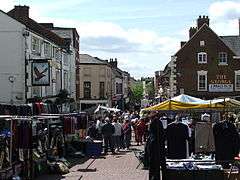 Oswestry Marketplace | |
 Coat of arms of Oswestry Motto: Floreat Oswestria ('May Oswestry flourish') | |
 Oswestry Location within Shropshire | |
| Population | 17,105 (2011 Census) |
| OS grid reference | SJ292293 |
| • London | 179 mi (288 km) SE |
| Civil parish |
|
| Unitary authority | |
| Ceremonial county | |
| Region | |
| Country | England |
| Sovereign state | United Kingdom |
| Post town | OSWESTRY |
| Postcode district | SY10, SY11 |
| Dialling code | 01691 |
| ISO 3166 code | GB-SHR |
| Police | West Mercia |
| Fire | Shropshire |
| Ambulance | West Midlands |
| UK Parliament | |
| Councillors |
|
| Website | Oswestry Town Council |
The town was the administrative headquarters of the Borough of Oswestry until that was abolished under local government reorganisation with effect from 1 April 2009. Oswestry is the third-largest town in Shropshire, following Telford and Shrewsbury. The 2011 Census recorded the population of the civil parish as 17,105[2] (up almost 10% from 15,613 in 2001) and the urban area as 16,660.[3] The town is five miles (8 km) from the Welsh border, and has a mixed English and Welsh heritage.[4]
Oswestry is the largest settlement within the Oswestry Uplands, a designated natural area and national character area.[5]
History
Prehistory
The oldest settlement in Oswestry is the 3000-year-old Old Oswestry, one of the most well preserved Iron Age hill forts in Britain, with evidence of construction and occupation between 800 BC and AD 43.[6]
The site is also named Caer Ogyrfan or The City of Gogyrfan, the father of Guinevere in legend.
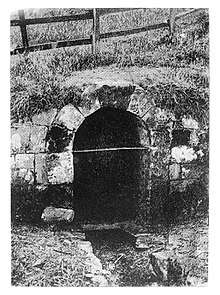
Saxon times
The Battle of Maserfield is thought to have been fought there in 642, between the Anglo-Saxon kings Penda of Mercia and Oswald of Northumbria. Oswald was killed in this battle and was dismembered; according to legend, one of his arms was carried to an ash tree by a raven. Miracles were subsequently attributed to the tree leading to a belief that the name of the town was derived from "Oswald's Tree".
There is an alternative view that Oswestry was named after Oswy,Oswald's brother, who fought a battle here against King Penda in 655 AD. Oswy became King of Northumbria after Oswald's death in 642 AD. The battle of 655 AD was fought near to a river called the Winwead, which it is believed, was the nearby River Vyrnwy. Welsh folklore has it that this battle was called the battle of Pengwern and in it their leader Cynddylan was also killed.
The spring, Oswald's Well, is supposed to have originated where the bird dropped the arm from the tree, though one historian suggested that it was likely to have been a pagan spring, in use long before the Saxon battle. The water from the well was believed to have healing properties, particularly for curing eye trouble.[7] Offa's Dyke runs near the well, to the west.
A far more likely derivation for the town's name is from the name "Oswald" and Old English treo in its sense "cross", giving a meaning "Oswald's Cross", as also seen in the town's traditional Welsh name Croesoswallt.[8]
The Conquest
The Domesday Book (1086) records a castle being built by Rainald, a Norman Sheriff of Shropshire: L'oeuvre (French for 'The work') – see Oswestry Castle.
Alan fitz Flaad (died c.1120), a Breton knight, was granted the feudal barony of Oswestry[9] by King Henry I who, soon after his accession, invited Alan to England with other Breton friends, and gave him forfeited lands in Norfolk and Shropshire, including some which had previously belonged to Ernulf de Hesdin (killed at Antioch while on crusade) and Robert of Bellême.[10]
Alan's duties to the Crown included supervision of the Welsh border. He also founded Sporle Priory in Norfolk. He married Ada or Adeline, daughter of Ernulf de Hesdin.[11][12] Their eldest son William FitzAlan was made High Sheriff of Shropshire by King Stephen in 1137. He married a niece of Robert of Gloucester.[13] Alan's younger son, Walter, travelled to Scotland in the train of King David I, Walter becoming the first hereditary Steward of Scotland and ancestor of the Stewart Royal family.
Border town
The town changed hands between the English and the Welsh a number of times during the Middle Ages and still retains some Welsh-language street and place names. In 1972, ITV broadcast a television report asking residents if they thought the town should be English or Welsh, with mixed responses. [14]
In 1149 the castle was captured by Madog ap Maredudd during 'The Anarchy', and it remained in Welsh hands until 1157. Occasionally in the 13th century it is referred to in official records as Blancmuster (1233) or Blancmostre (1272), meaning "White Minster".[15] Later, Oswestry was attacked by the forces of Welsh rebel leader Owain Glyndŵr during the early years of his rebellion against the English King Henry IV in 1400; it became known as Pentrepoeth or "hot village" as it was burned and nearly totally destroyed by the Welsh. The castle was reduced to a pile of rocks during the English Civil War.
The town is now the home of the Shropshire libraries' Welsh Collection.[16]
Market town
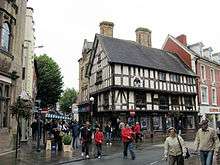
In 1190 the town was granted the right to hold a market each Wednesday.[17] With the weekly influx of Welsh farmers the townsfolk were often bilingual. The town built walls for protection, but these were torn down in the English Civil War by the Parliamentarians after they took the town from the Royalists after a brief siege on 22 June 1644, leaving only the Newgate Pillar visible today.
After the foot and mouth outbreak in the late 1960s the animal market was moved out of the town centre. In the 1990s, a statue of a shepherd and sheep was installed in the market square as a memorial to the history of the market site.
Military
Park Hall, a mile east of the town, was one of the most impressive Tudor buildings in the country. It was taken over by the Army during World War I in 1915 and used as a training camp and military hospital. On 26 December 1918 it burnt to the ground following an electrical fault. The ruined hall and camp remained derelict between the wars,[18] the camp hospital, however, was still in use; the Baschurch Convalescent and Surgical Home moved there in February 1921 and it became known as the Robert Jones and Agnes Hunt Orthopaedic Hospital.[19]
One of the main uses of the land from the 1920s was for motorcycle racing and it became quite a well-known circuit.[19]
The camp was reactivated in July 1939 for Royal Artillery training and the Plotting Officers' School.[19] Following World War II, Oswestry was a prominent military centre for Canadian troops, then for the British Royal Artillery, and finally a training centre for 15 to 17-year-old Infantry Junior Leaders. The camp closed in 1975. During the 1970s some local licensed wildfowlers discharged their shotguns at some passing ducks and were shot themselves by a young military guard, who had mistaken them for an attacking IRA force.[19]
The area previously occupied by the Park Hall military camp is now mainly residential and agricultural land, with a small number of light industrial units. Park Hall Farm became a visitor attraction in 1998, it is home to the Museum of the Welsh Guards.[19][20] The Park Hall Football Stadium (home of The New Saints FC) and The Venue (including bowling, gym and restaurant) are also on the site.[21]
Landmarks

Old Oswestry, situated on the northern edge of the town, dominates the northern and eastern approaches. The 3,000-year-old settlement is one of the most spectacular and best preserved Iron Age hill forts in Britain, with evidence of construction and occupation between 800 BC and AD 43.[6]
The site is also named Caer Ogyrfan (Welsh for 'Gogyrfan's Fortress'), the father of Guinevere in legend.
Other attractions in and around Oswestry include: Cae Glas Park, Shelf Bank, Wilfred Owen Green, Saint Oswald's Well at Maserfield, Castle Bank, and the Cambrian Railway Museum located near the former railway station.
The town is famous for its high number of public houses per head of population; there are around 30 in the town today, many of which offer real ale. A story incorporating the names of all of the pubs once open in Oswestry can be found hanging on a wall inside The Oak Inn on Church Street. There is a tapestry of 40 Oswestry pub signs on display in the town's Guildhall on the Bailey Head. The Stonehouse Brewery was opened in 2007, on the site of the former Weston Wharf railway station at Weston, in nearby Oswestry Rural; Stonehouse Brewery supplies many of the pubs with real ale.
Brogyntyn Hall which belonged until recently to the Lords Harlech lies just outside the town.[22] Upon leaving the Hall, Lord Harlech sold a few acres of field to Oswestry Town Council, for the purpose of conversion into parkland; this land is, today, called 'Brogyntyn Park' and is frequented daily.
Culture
There is a range of arts related activities in the town.
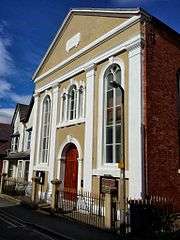
- The Qube
- Oswestry Visitor & Exhibition Centre
- Willow Gallery
- The Oswestry Town Museum
- Cambrian Railways Museum
- Attfield Theatre [23]
- Fusion Arts organises arts and music activities for young people.[24]
- Kinokulture, a cinema[25]
- Hermon Chapel Arts Centre[26]
- Oswestry Choral Society, the Oswestry Recorded Music Society, and the Oswestry Ladies Choir has developed.[27]
- OsRocks Choir
- Wilfred Owen Green[28]
- Borderlines Film Festival[29]
- The Oswestry Food and Drink Festival[30]
- Oswestry Balloon Festival[31]
- The Whittington International Chamber Music Festival[32]
Religion
In the 2011 Census, 68.7% of the population of Shropshire stated that their religion was 'Christian'. The second largest group (22.8%) stated that they had 'no religion'.[33]
.jpg)
There are a number of places of worship in Oswestry. There are two Church of England churches, which are part of the Diocese of Lichfield: St Oswald's Parish Church and the Holy Trinity Parish Church. St Oswald's Church was first mentioned in the 1085 Domesday book and a tithe document in Shrewsbury the same year.[34] St Oswald's Church is Grade II* listed, having a tower dating from late 12th or early 13th century and later additions particularly in the 17th and 19th centuries.[35] There is a new window in the east nave, designed by stained glass artist Jane Grey in 2004.
The town of Oswestry and surrounding villages fall into the parish of Our Lady Help of Christians and St Oswald, in the Roman Catholic Diocese of Shrewsbury. The single Catholic church is Our Lady and St Oswald's Catholic Church.[36] There is an associated primary school.[37]
There are two Methodist churches: the Horeb Church on Victoria Road and the Oswestry Methodist Church. Cornerstone Baptist Church is on the corner of Lower Brook Street and Roft Street in a modern 1970s building. Other Nonconformist churches include the Albert Road Evangelical Church, Hope Church (formerly Carreg Llwyd Church, Welsh for 'Grey Rock'), founded in 1964, and the Cabin Lane Church, established by members of the Hope Church in 1991 following the eastern expansion of Oswestry.[38]
Christ Church, now a United Reformed Church but formerly Congregationalist, was the home church of British composer Walford Davies.[39] There is a Welsh-speaking church, the Seion Church, and the Holy Anglican Church, a Western Rite Anglican establishment. Coney Green has a Jehovah's Witness Kingdom Hall. The Religious Society of Friends also holds meetings in Oswestry. The Grade II* star Hermon Chapel, by chapel architect Thomas Thomas, was a Welsh-speaking Congregational church[40] and is now an arts and community centre.
A small Muslim community exists in the town. A plan to transform a 19th-century former Presbyterian church on Oswald Road into a permanent base for meetings and prayer services fell through in March 2013 due to the cost.[41] New plans were submitted to Shropshire Council for approval in 2019, to convert the former Salvation Army citadel in King Street into an Islamic Prayer Centre. These plans were eventually approved by Shropshire Council.[42]
Healthcare
The Robert Jones and Agnes Hunt Orthopaedic Hospital NHS Trust in Oswestry provides elective orthopaedic surgery and musculoskeletal medical services.[43] The hospital is located towards Gobowen.
There is a Minor Injuries Unit on Thomas Savin Road, near the bus station.
Education
Oswestry is home to the second oldest 'free' (which in this context means not linked to any ecclesiastical foundation) school in the country, Oswestry School, which was founded in 1407. (The oldest, Winchester College, was founded in 1382.)[44] Oswestry School's 15th century site, adjacent to St Oswald's Parish Church, is now a heritage centre, housing the Tourist Information Centre, Shropshire Poacher Coffee Shop, and exhibitions.[45][46]
There are several primary schools such as Our Lady and St Oswald's Catholic Primary School[47] and Woodside Primary School, which became an academy on 1 May 2013. Secondary education is covered by two independent schools, Moreton Hall School (for girls) and the aforementioned Oswestry School (co-educational), and a comprehensive secondary school, The Marches School, which is also an academy. Further education is provided by North Shropshire College which is situated in the town at Shrewsbury Road and at the Walford Campus near Baschurch.
Transport
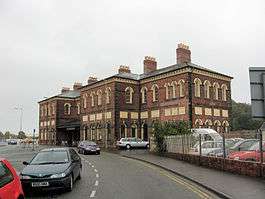
Oswestry is at the junction of the A5 with the A483 and A495. The A5 continues from Shrewsbury to the north, passing the town, before turning west near Chirk and entering Wales.
Bus services are operated by Arriva Midlands and local independents Tanat Valley Coaches, Lakeside Coaches and Owen's Travelmaster. The town has regular bus routes that link nearby villages and towns including Wrexham and Shrewsbury.
Gobowen railway station is 2 miles from the northern edge of Oswestry. It has direct services to Birmingham, Cardiff, Chester and North Wales. The original station name board 'Gobowen for Oswestry' is permanently displayed on the station platform.
Canals
The Llangollen Branch of the Shropshire Union Canal runs from Ellesmere to Llangollen, running 4.5 miles (7 km) miles east of the town at Hindford and on through Chirk, 6 miles (10 km) north. A navigable section of the partially restored Montgomery Canal, runs from Frankton Junction (connecting to the Llangollen Branch of the Shropshire Union Canal) to Newtown.[48]
Historic railways
The railway station, once on the main line of the Cambrian Railways, was closed in 1966 as a consequence of the Beeching cuts. Opened in 1840, the section from Whitchurch to Welshpool (Buttington Junction), via Ellesmere, Whittington, Oswestry and Llanymynech, closed on 18 January 1965, leaving only a short branch line from Gobowen to continue to serve Oswestry – but only until 7 November 1966. This former Great Western Railway (GWR) branch had once run into a separate GWR Oswestry terminus, but this has long since disappeared and the land redeveloped as a bus station and supermarket. Trains were re-routed into the main Cambrian station from 7 July 1924.
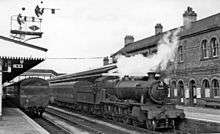
The main building of the Cambrian station is still a prominent landmark in the town centre: it once housed the headquarters of the Cambrian Railways company. After restoration, this building was reopened as the Cambrian Visitor Centre in June 2006 but closed on 11 January 2008. It later reopened, and has since evolved into the headquarters of the Cambrian Heritage Railways (CHR) and a small catering establishment known as "Buffers"; other parts of the building have been converted into retail and office units to contribute to the upkeep of the building.
A single railway track still runs through the station, once overgrown and rusting, it has been cleared and repaired and is the subject of an ambitious plan to reopen the line as a steam heritage railway between Oswestry and Llanyblodwel and Pant (to link with the restored Montgomery Canal – see above), and as a sustainable community transport rail link from Oswestry to the National Rail railway station at Gobowen.
By 2013, the main "up" platform at Oswestry station had been reconstructed and some new semaphore signalling installed. The branch-line track-bed from south of Gobowen to Llanyblodwel is now owned by Shropshire Council, who lease the land to CHR, a registered charity. Work is advancing in securing the transfer of the existing Transport & Works Act Order (TWAO) from Network Rail to CHR. The aim was for this transfer to be completed by 2014, and for the railway line between Gobowen and Oswestry to be fully re-instated and operational by 2017; however the legal process of the TWAO Unit administering a form of written debate between the proposer and objectors with a guided number of exchanges, was still ongoing in mid 2016. CHR purchase of the final section of the Oswestry to Gobowen railway branch line was completed in April 2016; nevertheless, other hurdles to becoming operational, such as permissions and finances to reinstate the level crossings on the main A5/A483 Trunk Roads, will also need to be overcome.
Immediately to the south of Oswestry Railway Station is the Cambrian Railways Museum; while a short distance to the north are the "listed" Works Bridge and the former Cambrian Railways works, which are now occupied by a variety of local commerce concerns and Oswestry's Community Health Centre and ambulance facility.
Sport
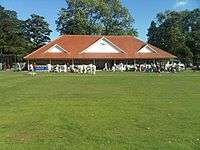
Since 2013, the town has been represented in football by F.C. Oswestry Town, who are currently members of the North West Counties Football League Division One South. The former local football club, Oswestry Town F.C., was one of the few English teams to compete in the League of Wales. It also won the Welsh Cup in 1884, 1901 and 1907.[49] The club folded due to financial difficulties in 2003 and merged with Total Network Solutions F.C. of Llansantffraid, a village eight miles (13 km) away on the Welsh side of the border. Following the takeover of the club's sponsor in 2006, the club was renamed as The New Saints. They moved to the redeveloped Park Hall Stadium on the outskirts of the town in September 2007. The New Saints or TNS is a full-time-professional football club that play in the Welsh Premier League, which they have won a record twelve times – including the past seven seasons.
Oswestry Lions F.C. of the Shropshire County League also play at the ground.
Recreation and leisure
From the 1700s to 1848, there was a popular racecourse outside the town. Known as Cyrn-y-Bwch (Welsh for 'the Horns of the Buck'), the site was chosen on this 1,000-foot (300 m) high hilltop because of its location between the Kingdom of England and the Principality of Wales, and the aim was to bring together the local landowners and gentry of Wales and England. Remnants of the old grandstand and figure-of-eight racetrack can still be seen.[50]
Nowadays, Oswestry Race Course is common land, registered under the Commons Act 1899 and the Countryside and Rights of Way Act 2000, with a number of rights of way on the South Common including Offa's Dyke Path and Bridleway. Also designated as a publicly accessible open space and a Wildlife Site in the 1999 Local Plan, it is an area reserved for:
- quiet, informal leisure activities and recreation;
- the biological diversity of the matrix of heathland, sparse woodland, ponds and ditches; and
- the sustainable management and conservation of nature and wildlife.
The site provides extensive views across the surrounding landscape of England and Wales.
The Llanymynech to Chirk Mill section of the Offa's Dyke Path National Trail crosses the common.[51]
For children, The Centre offers many sessions for entertainment.
Notable people
Arts and media
- Shirley Brooks (1816–1874) journalist, [53] novelist [54] and editor of Punch, lived there when training as a solicitor 1832–38
- William Archibald Spooner (1844–1930) Oxford don, [55] originator of the Spoonerism, educated at Oswestry School
- Sir Henry Walford Davies KCVO OBE (1869 in Oswestry – 1941) composer, [56] Master of the Queen's Music 1934 / 1941
- Wilfred Owen MC (1893 in Oswestry – 1918) poet [57] and soldier [58] in the first World War
- Ivor Roberts-Jones RA (1913 in Oswestry – 1996) sculptor, [59] sculpted Sir Winston Churchill in Parliament Square
- Barbara Pym (1913 in Oswestry – 1980) novelist, [60] Booker Prize nominee 1977
- Michael Croft OBE (1922 in Hengoed – 1986) actor, [61] schoolteacher and writer.
- Frank Bough (born 1933) former television presenter, [62] went to school in Oswestry
- Ian Hunter (born 1939 in Oswestry) lead singer [63] of the English rock band Mott the Hoople 1969 / 1974
- Philip Llewellin (1940 in Oswestry – 2005) journalist and writer, [64] went to Oswestry School
- Paul Jerricho (born 1948 in Oswestry) actor, [65] educated at Oswestry School
- Peter Edwards (born 1955) BP Portrait Award-winning artist, [66] went to Oswestry school
- Jesse Armstrong (born in Oswestry c. 1972) comedy writer, [67] best known for the Channel 4 sitcom Peep Show and the BBC political satire The Thick of It.
Public service
- Roger Palmer, 1st Earl of Castlemaine (1634–1705) courtier [68] and diplomat
- Owen Owen (1850–1920) teacher, headmaster and school inspector [69] in Wales
- Harold Whitfield (1886–1956) Victoria Cross [70] recipient
- Francis Humphrys (1879–1971) cricketer, [71] colonial administrator and diplomat
- John Lloyd Williams MC (1894-unknown), World War I flying ace, [72] Chief Constable [73] of Cardiganshire
- Trevor Rees-Jones (1968-) bodyguard [74] of Diana, Princess of Wales
Religion and Politics
- William FitzAlan, Lord of Oswestry (1105–1160) nobleman [75] of Breton ancestry, major landowner and a Marcher lord
- John FitzAlan, Lord of Oswestry, Clun and Arundel (1223–1267) Marcher Lord [76] with lands in the Welsh Marches.
- David Holbache (c.1355 – c.1422) Welsh politician, MP for Shropshire, [77] founded Oswestry School [78] in 1407.
- Robert Ussher, (1592–1642) Provost of Trinity College, [79] Dublin and Bishop of Kildare, buried at Doddleston Chapel, near Oswestry
- Thomas Bray (c.1657–1730) clergyman [80] and abolitionist, went to Oswestry School
- Stanley Leighton (1837 – 1901) barrister, landowner, [81] artist, antiquarian and Conservative MP for Oswestry 1885 / 1901
- George Ormsby-Gore, 3rd Baron Harlech (1855–1938) British soldier [82] and Conservative MP for Oswestry 1901 / 1904
- William Griffith Thomas (1861 in Oswestry – 1924) Anglican cleric [83] and scholar
- William Bridgeman, 1st Viscount Bridgeman (1864–1935) Home Secretary [84] 1922 / 1924 and Conservative MP for Oswestry 1906 / 1929
- Kate Williams Evans (1866-1961) suffragette died in Oswestry
- Bertie Leighton (1875–1952) Army officer, landowner [85] and Conservative MP for Oswestry 1929 / 1945
- David Ormsby-Gore, 5th Baron Harlech (1918–1985) diplomat [86] and Conservative MP for Oswestry 1950 / 1961
- John Biffen (1930–2007) respectfully regarded [87] Conservative MP for Oswestry 1961 / 1997
- George Foulkes, Baron Foulkes of Cumnock (born 1942 in Oswestry) former [88] Scottish Labour Co-operative MP, now life peer
Science, Medicine & Business
- Thomas Mainwaring Penson (1818 in Oswestry – 1864) surveyor and architect, [89] educated at Oswestry School
- Thomas Savin (1826 in Llwynymaen – 1889 in Oswestry) railway engineer, [90] buried Oswestry Cemetery
- Edward Weston (1850 in Oswestry – 1936) chemist, [91] developed electroplating and the Weston cell in the USA
- Northcote W. Thomas (1868 in Oswestry - 1936) British anthropologist [92] and psychical researcher
- Katharine Lloyd-Williams CBE (1896 in Oswestry – 1973) anaesthetist, [93] general practitioner and medical educator
- Gordon Jackson Rees (1918 in Oswestry – 2001) anesthesiologist [94] and a pioneer in pediatric anesthesia
- Dame Steve Shirley CH DBE FREng FBCS (born 1933) information technology pioneer, [95] businesswoman and philanthropist, Kindertransport child refugee, lived at Oswestry for six years and attended Oswestry Girls' High School.[96]
- Per Lindstrand (born 1948) Swedish aeronautical engineer and pilot, [97] founded Lindstrand Balloons in Oswestry
- Ian Robertson CMG (born 1958 in Oswestry) automotive executive, [98] MD of Land Rover, now on the Board of BMW Group
Sports
- Alfred Payne (1849 in Oswestry – 1927) cricketer for the Marylebone Cricket Club
- Di Jones (1867 in Trefonen – 1902) Welsh international footballer, 340 club caps for Bolton Wanderers F.C. and Manchester City F.C.
- Charlie Morris (1880 in Oswestry – 1952) footballer, 277 club caps for Derby County F.C.
- George Wynn (1886 in Treflach – 1966) Welsh professional footballer [99]
- Herbie Roberts (1905 in Oswestry – 1944) footballer, [100] 297 club caps for Arsenal F.C.
- Harry Weetman (1920 in Oswestry - 1972) golfer
- Fred Morris (1929 in Oswestry – 1998) footballer, [101] 350 club caps, mainly for Walsall F.C.
- Andy Lloyd (1956 in Oswestry) England test cricketer [102] and captain of Warwickshire CCC
- Ian Woosnam OBE (born 1958 in Oswestry) Welsh professional golfer [103]
- Carl Griffiths (born 1971 in Oswestry) retired footballer, [104] 334 club caps beginning at Shrewsbury Town F.C.
- Darren Ryan (born 1972 in Oswestry) former footballer, [105] over 300 club caps; now trains youngsters at Wolves
- Paul Evans (born 1974 in Oswestry) retired footballer, [106] 475 club caps beginning at Shrewsbury Town F.C.
- Boaz Myhill (born 1982) football goalkeeper, [107] over 350 club caps, mostly for Hull City F.C.
- Amy Hughes (born 1987) marathon runner, [108] a sports therapist in Oswestry
- Matt Done (born 1988 in Oswestry) professional footballer, [109] over 350 club caps, plays for Rochdale
See also
- Listed buildings in Oswestry
- Battle of Oswestry - Civil War
References
- http://www.bbc.co.uk/shropshire/content/articles/2008/09/19/oswestry_railway_feature.shtml
- Population Density, 2011 Archived 4 September 2014 at the Wayback Machine, Neighbourhood Statistics, 2011 Census, Office for National Statistics, retrieved 3 September 2014
- "Oswestry". World Gazetteer. Retrieved 14 May 2008.
- Shropshire Tourism. "Oswestry & the Welsh Borders". Archived from the original on 29 October 2018. Retrieved 3 March 2009.
- NCA 63: Oswestry Uplands Key Facts & Data at www.naturalengland.org.uk. Accessed on 5 April 2013.
- "History of Old Oswestry Hill Fort". English Heritage.
- Hope, Robert Charles (1893). The legendary lore of the holy wells of England: including rivers, lakes, fountains and springs. London: Elliot Stock. pp. 143–145. Retrieved 7 February 2018.
- Charles, B. G. (1938). Non-Celtic Placenames in Wales. London Medieval Studies Monographs, 1. p. xlvi.
- Burke, Messrs., John and John Bernard, The Royal Families of England, Scotland, and Wales, and Their Descendants &c., volume 2, London, 1851, p. xl.
- Ritchie, R. L. Graeme, The Normans in Scotland, Edinburgh University Press, 1954, p.280-1
- Round, J. H., Studies in Peerage, p.123
- Ritchie (1954) p.98n and 280-1
- Ritchie (1954) p.281
- "Watch: 43 years on - should Oswestry be in England or Wales?". Shropshire Star. 13 May 2015. Retrieved 4 January 2020.
- E. Ekwall, 'Concise Oxford Dictionary of English Place-Names', 4th ed., 1960
- Shropshire Council. "Welsh Collection at Oswestry Library". Retrieved 3 March 2009.
- "Oswestry Market". Shropshire Tourism.
- Shropshire Routes to Roots. "Introduction to Park Hall". Shropshire County Library Service. Archived from the original on 23 June 2007.
- "Gazetteer of Sites: Park Hall Barracks, Oswestry (SJ3031)". Shropshire History.
- "The Welsh Guards Collection: The Official Welsh Guards Museum". Welsh Guards. Archived from the original on 4 June 2014. Retrieved 27 March 2015.
- "Park Hall Stadium". New Saints FC. Archived from the original on 2 April 2015.
- John S Turner. "Brogyntyn Hall, near Oswestry (C) John S Turner :: Geograph Britain and Ireland". geograph.org.uk. Retrieved 17 May 2015.
- "Attfield Theatre – Welcome!". attfieldtheatre.co.uk. Retrieved 17 May 2015.
- "Fusion Arts Oswestry – Opening the Arts to Everyone". fusionartsoswestry.co.uk. Archived from the original on 2 April 2015. Retrieved 17 May 2015.
- "HOME – Oswestry's Community Cinema". kinokulture.org.uk. Retrieved 17 May 2015.
- "Hermon Chapel". Retrieved 29 April 2017.
- "Oswestry Ladies Choir". Retrieved 12 November 2016.
- "Borderlines Film Festival". Retrieved 17 May 2015.
- "Oswestry Food Festival". oswestryfoodfestival.co.uk. Archived from the original on 16 February 2016. Retrieved 17 May 2015.
- "Oswestry Balloon Festival". Retrieved 6 July 2018.
- "Whittington International Chamber Music Festival". Retrieved 30 April 2017.
- Office of National Statistics
- "St Oswald Church Oswestry – Church History". stoswaldsoswestry.org.uk. Retrieved 17 May 2015.
- "Church of St Oswald, Oswestry". British Listed Buildings. Retrieved 7 February 2016.
- "Home Page". osoprimary.co.uk. Retrieved 17 May 2015.
- "Cabin Lane Church – Who are we?". Cabin Lane Church. Retrieved 27 March 2015.
- "Christ Church – Picture and Notes". Retrieved 31 December 2007.
- "Hermon Chapel, Oswestry". British Listed Buildings. Retrieved 7 February 2016.
- "Muslim prayer centre plan for church dropped". Shropshire Star. 5 April 2013. p. 1.
- Morris, Andrew. "Oswestry Muslim centre plan gets go-ahead". www.shropshirestar.com. Retrieved 1 February 2020.
- "History of Oswestry Orthopedic Hospital". NHS. Archived from the original on 29 September 2007.
- "History - Oswestry School". oswestryschool.org.uk. Retrieved 10 August 2016.
- "Oswestry Town Council: Visitor and Exhibition Centre". oswestry-tc.gov.uk. Retrieved 10 August 2016.
- "Welcome to Oswestry". oswestry.com. Retrieved 10 August 2016.
- "Our Lady and St Oswald's Catholic Primary School". Retrieved 30 April 2017.
- Lewery, Tony. "The Montgomery Canal". Canal Junction. Retrieved 18 January 2008.
- "Welsh Cup " Champions". worldfootball.net. Retrieved 17 May 2015.
- Greyhound Derby "Oswestry racecourse". Date retrieved: 14 August 2013
- "Hikeview Offa's Dyke Page". Hikeview.co.uk. Retrieved 9 September 2013.
- "Oswestry Twinning Association". Oswestry Twinning Association. 2015. Retrieved 4 March 2018.
- . Dictionary of National Biography. 06. 1886.
- . Encyclopædia Britannica. 04 (11th ed.). 1911.
- Manchester Guardian, 1 September 1930, archived obituary retrieved 17 March 2018
- National Library of Wales, Dictionary of Welsh Biography, DAVIES, Sir HENRY WALFORD retrieved 17 March 2018
- Wilfred Owen at the British Library retrieved 17 March 2018
- Wilfred Owen Association retrieved 17 March 2018
- Profile on Royal Academy of Arts Collections retrieved 17 March 2018
- The Barbara Pym Society based at St Hilda's College, Oxford Archived 26 February 2017 at the Wayback Machine retrieved 17 March 2018
- IMDb Database retrieved 17 March 2018
- IMDb Database retrieved 17 March 2018
- The Guardian, 3 September 2009, Mott the Hoople, The dudes abide retrieved 17 March 2018
- The Guardian, 6 Oct 2005, Obituary, Phil Llewellin retrieved 17 March 2018
- IMDb Database retrieved 17 March 2018
- National Portrait Gallery, Peter Edwards retrieved 17 March 2018
- IMDb Database retrieved 17 March 2018
- . Dictionary of National Biography. 43. 1895.
- Dictionary of Welsh Biography Online, National Library of Wales, OWEN, OWEN retrieved 17 March 2018
- Location of grave and VC medal (Shropshire) retrieved 17 March 2018
- ESPN cricinfo Database retrieved 17 March 2018
- The Aerodrome, John Jordan Lloyd Williams retrieved 17 March 2018
- BBC News Channel, 23 October, 2004, Secrets of jailed rebel exposed retrieved 17 March 2018
- BBC News, 6 March, 2000, Diana's bodyguard: What's the story? retrieved 17 March 2018
- . Dictionary of National Biography. 19. 1889.
- . Dictionary of National Biography. 19. 1889.
- The History of Parliament Trust, HOLBACHE, David (d.c.1422), of Dudleston and Oswestry, Salop retrieved 17 March 2018
- Introduction to the History of Oswestry School retrieved 17 March 2018
- . Dictionary of National Biography. 58. 1899.
- . Encyclopædia Britannica. 04 (11th ed.). 1911.
- HANSARD 1803–2005 → People (L), Mr Stanley Leighton retrieved 17 March 2018
- HANSARD 1803–2005 → People (O), Hon. George Ormsby-Gore retrieved 17 March 2018
- Church Society, William Henry Griffith Thomas (1861-1924) retrieved 17 March 2018
- HANSARD 1803–2005 → People (B), Mr William Bridgeman retrieved 17 March 2018
- HANSARD 1803–2005 → People (L), Major Bertie Leighton retrieved 17 March 2018
- HANSARD 1803–2005 → People (O), Mr William Ormsby-Gore retrieved 17 March 2018
- HANSARD 1803–2005 → People (B), Mr John Biffen retrieved 17 March 2018
- Parliament, Lords, Lord Foulkes of Cumnock retrieved 17 March 2018
- Oswestry Town Trail, Willow Street, Shropshire County Council retrieved 17 March 2018
- Biographies of chairmen, managers & others, STEAMINDEX retrieved 17 March 2018
- Weston, The Company and The Man retrieved 17 March 2018
- Museum of Archaeology and Anthropology, Northcote W. Thomas and his collection retrieved 17 March 2018
- Royal College of Anaesthetists, Dr Katharine Georgina Lloyd-Williams retrieved 17 March 2018
- Gordon Jackson Rees FRCA FRCP FRCPCH, Proceedings of the History of Anaesthesia Society Archived 8 May 2016 at the Wayback Machine retrieved 17 March 2018
- Dame Stephanie "Steve" Shirley at TED retrieved 17 March 2018
- "Dame Stephanie to return to Oswestry". Shropshire Star. 1 April 2015. p. 23.Report by Sue Austin. She was about to attend Oswestry Literary Festival to promote her autobiography and said of her time, "In Oswestry I had six wonderful years of peace" after World War II.
- Lindstrand Technologies Ltd. (UK company), Founder and Inspirer of.... Archived 18 March 2018 at the Wayback Machine retrieved 17 March 2018
- BBC News, 7 March 2014, Geneva Motor Show: A Briton at the wheel of BMW retrieved 17 March 2018
- Football & the First World War website, George Wynn retrieved 17 March 2018
- Arsenal.com, historic players, Herbie Roberts retrieved 17 March 2018
- Player profile, LFC history.net retrieved 17 March 2018
- ESPN cricinfo Database retrieved 17 March 2018
- Ian Woosnam, Official World Golf Ranking website retrieved 17 March 2018
- SoccerBase Database retrieved 17 March 2018
- SoccerBase Database retrieved 17 March 2018
- SoccerBase Database retrieved 17 March 2018
- SoccerBase Database retrieved 17 March 2018
- BBC News, 27 September 2014, Amy Hughes completes..... retrieved 17 March 2018
- SoccerBase Database retrieved 17 March 2018
External links
| Wikimedia Commons has media related to Oswestry. |
| Wikivoyage has a travel guide for Oswestry. |
- . Encyclopædia Britannica. 20 (11th ed.). 1911.
- Oswestry Town Council